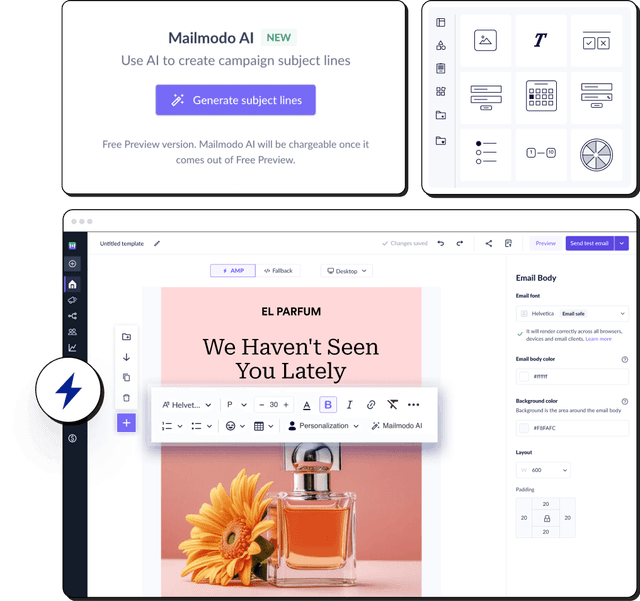What is Apple Mail Privacy Protection?
Apple Mail Privacy Protection is a feature introduced by Apple that enhances user privacy by preventing email senders from tracking email opens and users' IP addresses. When enabled, it automatically loads the email content, like images, on the device in a way that masks the user's location and activity, thus blocking tracking pixels and other mechanisms used to monitor email interactions.
Note: MPP is available on the Mail app with Apple's iOS 15, iPad OS 15, and macOS Monterey devices. So, the mail service doesn’t matter; as long as you use any of the iOS devices mentioned above, MPP will be enabled.
How does Mail Privacy Protection (MPP) work?
With this new iOS 15 update, all the email content will be downloaded in the background, regardless of whether a user has opened the email or not. Since all the data is rendered even before the user opens his/her email, the email open data you get will be inflated as all the emails that you send will be tracked as opened.
Let’s take a look at how MPP works in detail:
Step 1: Email downloads are triggered when a user opens the Apple Mail app.
Step 2: Apple downloads all the images in the email, creating a copy to a new location on the Apple Privacy Cache. This can happen randomly and at any time, i.e., immediately or after a couple of days. The email download is triggered by a proxy server with an IP address that masks their specific geolocation.
Step 3: Apple’s caching process requests images, including the open tracking pixel, from an email service provider (ESP) like Mailmodo. This can lead to misleading tracking as the ESP thinks the email has been opened.
Step 4: When subscribers do open the email, download requests are triggered, but instead of coming from the sender’s web host or the ESP server, it’s coming from the Apple Cache. This means you won’t be able to track the real open.

How to enable Apple Mail Privacy Protection
Apple Mail Privacy Protection is turned on by default if Apple Mail is your default email client. In other cases, you need to manually enable this feature in your Apple devices. Here’s how you can do it:
If you open the Apple Mail app after downloading iOS 15, then Apple will, by default, tell you everything about MPP. You need to select the Protect Mail activity button from the options given and you’re done.

If you haven’t set it up when you were prompted about the MPP feature, here’s how you can do it manually:
Step 1: Open the Settings on your Apple device.
Step 2: Go to Mail, and find Privacy Protection.
Step 3: Turn on the toggle button next to Protect Mail Activity.
 So, that’s how you enable the MPP feature on your Apple devices. But what if you’re on the other end of the email? What happens to your emails if you’re sending them to Apple users who have this feature turned on?
So, that’s how you enable the MPP feature on your Apple devices. But what if you’re on the other end of the email? What happens to your emails if you’re sending them to Apple users who have this feature turned on?
What impact does MPP have on email marketers?
Apple's Mail Privacy Protection (MPP) inflates email open data, making it harder for email marketers to gauge how their target audience who have enabled MPP engage with their emails.
While click tracking remains available, the lack of genuine open tracking data complicates identifying disengaged contacts and assessing email campaign performance.
You might decide not to depend on opens as a measure of your email marketing success, but email open data offers valuable information for tactics based on Artificial intelligence (AI).
Some of the impacts that Apple mail privacy protection has are as follows:
1. Flawed A/B testing subject lines
You won’t get accurate results after conducting subject line A/B testing on Apple Mail users. Therefore, you need to rethink the strategies you use to optimize your subject lines, as open rates might not reflect the effectiveness of your subject lines.
2. Flawed send-time optimization
Send time optimization (STO) is based on the user’s email open timings as part of its algorithm to determine the right time to send the email. So, STO will be flawed due to overinflated openings and wrong timings.
3. Difficult to track email deliverability
Monitoring inbox placement will become challenging as you cannot rely on opens to ensure that your email has landed in the inbox.
4. Challenging to maintain email list hygiene
You will need to dive deeper into users’ behavior to get active or inactive data without open rates. Open rate is the foremost metric used to remove inactive users, but your job becomes even more challenging without it.
5. Restructure automated flows and journeys
All the automated journeys designed to send emails based on open timing will become useless as users’ actual opening timing can’t be tracked. So, you need to re-create all the automation for the Apple Mail users.
6. Challenges to email personalization
Apple’s Mail Privacy Protection hides email open data, making it difficult for marketers to track engagement. This limits their ability to personalize emails and tailor future communications based on user behavior. Personalization of emails is affected as follows:
Localized emails such as nearest store location, and weather-based content created using their IP addresses won’t be accurate.
Countdown timers might show outdated times due to discrepancies in sent timings and the actual open timings.
How has the new iOS 15 update impacted email marketers?
Email marketers were concerned about their campaigns’ effectiveness because they feared that it would be hard to measure email marketing performance and make data-driven decisions without tracking open rates. However, in 2022, the overall impact on email senders has been relatively modest. According to a study on email marketers:
47% reported that data privacy changes had a neutral effect on their email marketing strategy
29% found the changes had a negative impact
24% saw a positive impact from the privacy changes
Email marketers initially feared that MPP, with its new email privacy features, would pose a disadvantage with limited performance metrics, personalization challenges, and strategy adjustments. However, 61% of marketers have noted that this new privacy change has provided an opportunity to innovate their email strategies. Marketers must reassess strategies that depend exclusively on open rates and incorporate new performance metrics.
How to deal with Apple MPP
Whether you like it or not, the Apple MPP feature is here to stay. We've already discussed how it affects your email marketing efforts. Here are some tips for you to follow to deal with this update:
1. Determine the email client breakdown of your audience
As per Litmus’s November 2021 email client share report, iOS users accounted for 54.02%, and over half of the email opens came from Apple users.
Understanding which email clients your audience uses helps you adjust your strategies. By checking your email analytics, you can see the breakdown of email clients. For example, if many of your recipients use Apple Mail, you need to know how Mail Privacy Protection (MPP) might impact your metrics. With MPP, open rates might not be accurate, so focus more on metrics like click-through rates and conversions. Separate Apple Mail users from others to better track performance and tailor specific strategies for specific segments.
2. Look for alternative engagement metrics
As open rates become less reliable with the adoption of MPP, it is crucial to explore alternative methods for evaluating your email campaign’s performance.
Click data is the most straightforward substitute. Clicks represent intentional actions and, thus, offer a great way of tracking recipient engagement.
Another important metric you can calculate is the email quality score; a concept shared in the Really Good Emails podcast by Lucas Chevillard, the former Email Marketing Specialist at Airbnb.
Email quality score shows the percentage of users happy with your emails. This score helps you understand the engagement quality and should be added to your reporting.
Email quality score = [1 - (unsubscribers/responders)] x 100.
This score must be aimed to be at 80% or more.
3. Evaluate current activities for open rate reliance and update them
Before developing new automation strategies, identify which tactics rely on open rates. Some of such dependencies can be:
Send time optimization
Subject line A/B testing
Automated emails triggered by opens
Segmentation based on location or opens
Localized content
Countdown timers
Suppression lists of unengaged users
Deliverability or inbox placement monitoring
After evaluating these dependencies, you can eliminate them to avoid future inaccuracies that might hurt your entire email campaign.
4. Get user feedback via surveys and polls
Email metrics can’t tell you what talking to people regularly can.
- Ashley Guttuso, Director of Marketing at Simple Focus
To know how users find your emails, and what they like and dislike, ask them directly. Send out surveys and feedback forms to understand if what you’re sending resonates with them.
Way forward
Being a marketer comes with its challenges, especially when it comes to personalizing interactions and connecting with customers. Apple Mail Privacy Protection (MPP) might affect how you engage with your audience, but it also offers an opportunity to reassess and refine your strategies.
While MPP will impact how your email campaigns perform, it shouldn’t be a source of fear. To succeed in the long run, you need to adapt your email marketing strategies to align with these privacy changes.
To stay relevant and effective, follow the methods outlined in our guide. This will help you adjust your approach and ensure that your email marketing efforts continue to deliver results despite the new privacy landscape.




 So, that’s how you enable the MPP feature on your Apple devices. But what if you’re on the other end of the email? What happens to your emails if you’re sending them to Apple users who have this feature turned on?
So, that’s how you enable the MPP feature on your Apple devices. But what if you’re on the other end of the email? What happens to your emails if you’re sending them to Apple users who have this feature turned on?






